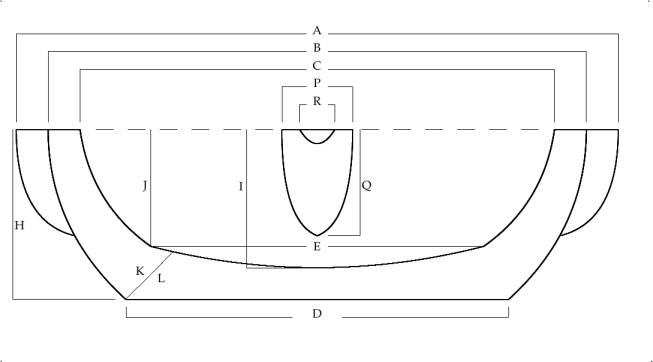John Palmer, May 2005

All measurements in millimetres.
A extreme diameter at rim level, over lugs
B outer diameter at rim level, apart from lugs
C inner diameter at rim level
D outer diameter of base
E inner diameter of base *
H outer height, rim to base
I inner depth, rim to base at centre
J inner depth, rim to base-wall junction *
* Measurements E and J are only made if there is a distinct angle in the profile of the inner surface between the base and wall of the mortar. Measurements K and L can however be made in most mortars; it is not clear which will prove the more useful.
K maximum thickness measured at 45 degrees to vertical,
not through a lug
L thickness measured at 45 degrees to vertical
through the external angle (also called carina)
between outside of base and outside of wall
(in the mortar shown these measurements happen to coincide)
P extreme breadth of lug
Q extreme height of lug
R width of pouring channel
Where lugs differ markedly in size, measurements P and Q may be repeated for each lug, as may R if there is more than one pouring channel.
In the case of the elongated Norden mortar, measurements B and C may be repeated for long and short axes. Measurement A applies only to the short axis as there is no lug on the long; R however refers to the channel on the long axis, as there is no channel on the short. There are also other unusual mortars on which special measurements will be taken, e.g. tripod mortars.
For broken mortars, measurements refer to the complete mortar, and will be omitted if they cannot be reasonably inferred. For unfinished mortars, also, many measurements may be impossible.
The symbols [ and ( have been used to indicate `straight-sided' and `rounded-base' mortars respectively. This is a subjective classification, and the ratio B/D may be a better indicator of this aspect of shape. / is used for a subconical shape, much wider at rim than base.
Where measurements are taken from a drawing,
"sc 1/4" means the scale is stated to be 1/4,
"scb 1/4" indicates a scale taken from a scalebar in the drawing,
"scb" alone means the scalebar agrees with the stated scale.
If the stated scale and the scalebar disagree,
the scalebar is taken as authoritative.